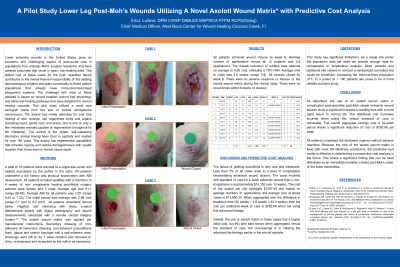Clinical Research
(CR-042 (RPT-004)) Post-moh's Wound Healing in a Pilot Study of a Novel Axolotl Regenerative Tissue
Friday, May 2, 2025
4:45 PM - 5:45 PM East Coast USA Time

Introduction: This pilot study of 10 patients with non-healing post-Moh's surgical excisions consisting of 7 squamous cell carcinomas and 3 basal cell carcinomas. The use of a novel Axolotl tissue, from the skin of salamanders, was utilized in the process of healing these non-healing surgical wounds. The axolotl has innate attributes for scar free healing of skin wounds, can regenerate limbs and organs (including heart, spinal cord, and brain), and is one of only a few vertebrate animals capable of regeneration throughout its life1,2. The axolotl is the oldest, self-sustaining laboratory animal having been bred in captivity and studied for over 150 years.3 This animal has regenerative capabilities that remodel, regrow, and restore damaged tissue with results superior than those seen in human tissue repair. This pilot study hypothesizes the use of a new Axolotl tissue graft for use in post-Moh's non-healing surgical sites with accelerated healing reponse.
Methods: Each patient identified and qualified for the pilot study had successively failed 4 weeks of conservative therapy. All patients underwent ABI screening and nutritional assessment. Weekly applications to the target wounds were identified and measured via CarePICS®. Vascular assessment post-ABI and prior to applications were perfomed via Near-infrared spectrograhic imaging via the Kent SnapShot IR® device. Wounds were then debrided via sharp surgical technique with removal of non-viable necrotic tissue. NeoMatrix® Tissue Matrix was then applied to the target wound site and anchored with 1/2" steri-strips. Top dressing applied and patients seen weekly.
Results: The results of this trial were sensitive to the relative initial wound sizes and healing outcomes. The median age of the data set was 81.2 years old. There were 8 Caucasian and 2 Hispanic patients. 7 of the patients were female, 3 male. Overall, the average number of applications for the 10 patient population was 2.8 with a starting mean wound size of 2.98 cm2. Average ABI for all 10 patients was 1.08. Average wound size at 4 weeks was 0.66cm2. 4 wounds were closed by week 4, 4 wounds at week 5, 1 wound at week 6 and 1 wound at week 8.
Discussion: The use of a new novel Axolotl tissue matrix while new to the wound healing community, has advantages of regenerative capabilities that are only minorly demonstrated in this early pilot trial.
Methods: Each patient identified and qualified for the pilot study had successively failed 4 weeks of conservative therapy. All patients underwent ABI screening and nutritional assessment. Weekly applications to the target wounds were identified and measured via CarePICS®. Vascular assessment post-ABI and prior to applications were perfomed via Near-infrared spectrograhic imaging via the Kent SnapShot IR® device. Wounds were then debrided via sharp surgical technique with removal of non-viable necrotic tissue. NeoMatrix® Tissue Matrix was then applied to the target wound site and anchored with 1/2" steri-strips. Top dressing applied and patients seen weekly.
Results: The results of this trial were sensitive to the relative initial wound sizes and healing outcomes. The median age of the data set was 81.2 years old. There were 8 Caucasian and 2 Hispanic patients. 7 of the patients were female, 3 male. Overall, the average number of applications for the 10 patient population was 2.8 with a starting mean wound size of 2.98 cm2. Average ABI for all 10 patients was 1.08. Average wound size at 4 weeks was 0.66cm2. 4 wounds were closed by week 4, 4 wounds at week 5, 1 wound at week 6 and 1 wound at week 8.
Discussion: The use of a new novel Axolotl tissue matrix while new to the wound healing community, has advantages of regenerative capabilities that are only minorly demonstrated in this early pilot trial.

.jpg)
